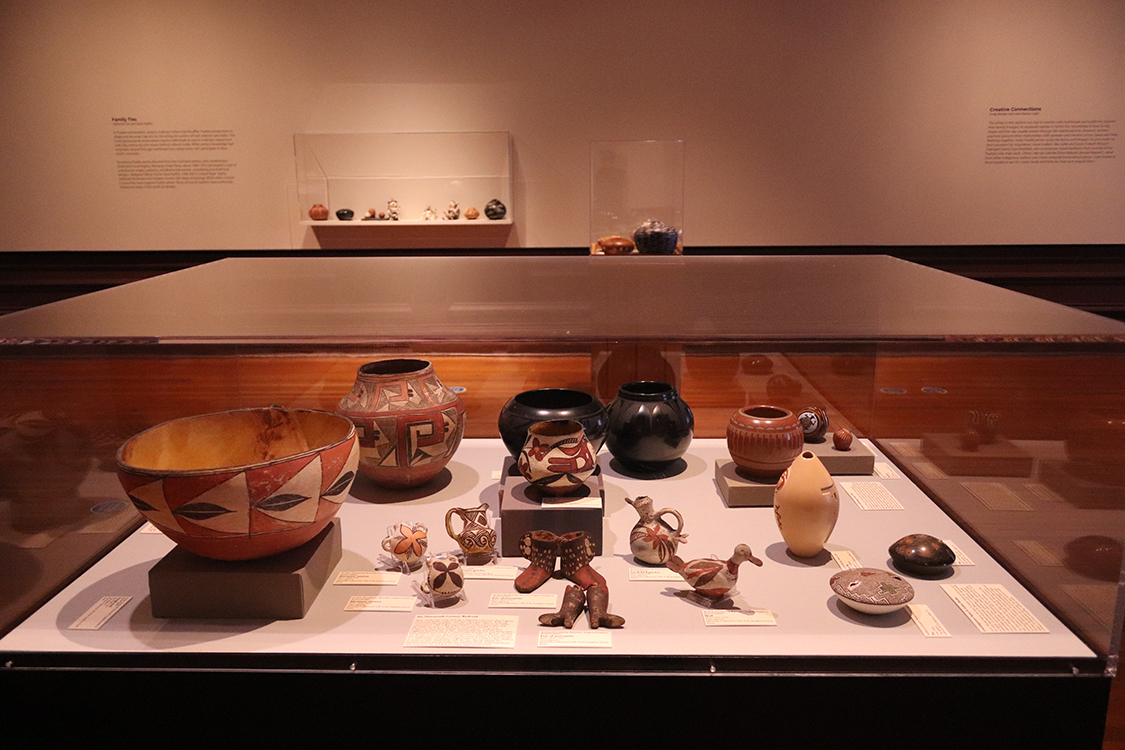Rose Sheehan and Emily Francisco
In the center of this gallery, four distinct moments in the histories of Pueblo clay arts
form a continuum that grounds contemporary artmaking. From turn-of-the-century
railroad tourism to today’s Santa Fe Indian Market, Pueblo communities harness a
Euro-American market for Indigenous clay arts to nourish and carry forward their
cultural heritage. In these moments, Pueblo clay artists negotiate the realities of white
settler violence and coercion; they also channel artistic resistance through clay.
Within Pueblo worldviews, the spiral often structures movement across space and
time. Spiraling outward from these four historical moments, Grounded Innovation also
gestures inward to them, inviting non-linear connections among makers, meanings,
and the clay forms that contain and reflect them. Throughout this exhibition, visitors
are encouraged to revisit the center case, collapsing the distance between history and
the present.


Change in the Nineteenth Century
Beginning in the late nineteenth century, the federal government enacted policies to assimilate Indigenous communities into the economy and culture of the United States. Government-sponsored “field matrons,” including a woman from Delaware named Josephine Foard, went West to impose Euro-American religious, social, and artistic values on Indigenous women. These four works are the result of complex interactions between Foard and Pueblo clay artists. Foard tried to glaze pottery for sale, but the artists ultimately rejected her efforts.

The Nineteenth-Century Railroad
These vessels and curios embody a negotiation between their Laguna and Acoma Pueblo makers and Euro-American buyers. Railroads connected anthropologists, tourists, and other collectors to Pueblo communities. Clay artists responded by producing portable and affordable miniatures. While tiny moccasins catered to non-Indigenous ideas about Pueblo material culture, small pitchers suggested practical use. In fact, creamers like the tiny one shown here were shipped eastward in an unsuccessful attempt to open an “Indian Tea Room” in Boston. But miniatures have a place in Pueblo clay arts that predates and extends beyond the tourist market. A miniature fits in a child’s palm, and parents might hand such vessels to their children to invite an early relationship with the clay. And as vehicles for experimentation and showcases for exquisite detail, small-scale forms have long been the end goal for many experienced artists.

Markets of the 1920s and 1930s
Reinventing an ancestral pottery technique of low-oxygen firing, Maria and Julian Martinez’s distinctive black-on-black vessels dominated the prize-giving at the 1922 Indian Fair, the first iteration of the Santa Fe Indian Market. In the Market’s early years, Euro-American administrators screened artworks for inclusion, judged entries, and superintended sales. These organizers defined “authentic” Pueblo pottery and singled out Maria as the symbol of its revival. At their insistence, Maria began signing her vessels, a practice that obscured her embeddedness in a network of teachers, collaborators, and fellow black-on-black potters. It was not until 1936 that Pueblo clay artists were able to select works for display at Indian Market and sell directly to customers. Harnessing the Market to assert personal and communal artistic identity, they continue to grapple with the power dynamics baked into its origins.

Activist Collecting in the 1970s
( object group front right-side )
In the 1960s and 1970s, the Red Power movement gained momentum. As Native American activists fought for Indigenous sovereignty, restoration of treaty lands, and human rights, the purchase of Indigenous art signaled support for such causes. With the spotlight on the Native art world, many Pueblo artists experimented with clay techniques, incorporating both new and ancient forms in their pottery. Blue Corn’s Jar with Feathers & Clouds showcases the artist’s famous polychrome surfaces, a colorful technique inspired by ancestral pottery fragments. The two small rounded works are by Joseph Lonewolf, who was one of the first to incorporate the “sgraffito” or intricate carving technique on the surface of his pottery. Inspired by ancient Mimbres ceramics, his jewel-like miniatures often feature animal forms.
Contemporary Santa Fe Indian Market
( object group front left-side )
In its 100-year history, the Santa Fe Indian Market has become one of the most important events in the Native art world. Now held annually in August, it is simultaneously a gathering, a celebration, a juried exhibition, and an economic crossroads. Indian Market facilitates relationships between artists, collectors, dealers, curators, and others from around the globe. Participating artists come from all over North America, though the majority are from the Southwest.
The three works shown here reflect the innovative techniques that draw countless visitors to Pueblo homelands. Rebecca Lucario’s intricate geometric patterns were painted with clay slips on traditional Acoma clay. Rebecca Gonzales, the great-granddaughter of Maria Martinez, incorporates inset stones on the surfaces of her etched designs. Al Qöyawayma uses carving, clay slips, and stone polish techniques to create compelling sculptural vessels.

